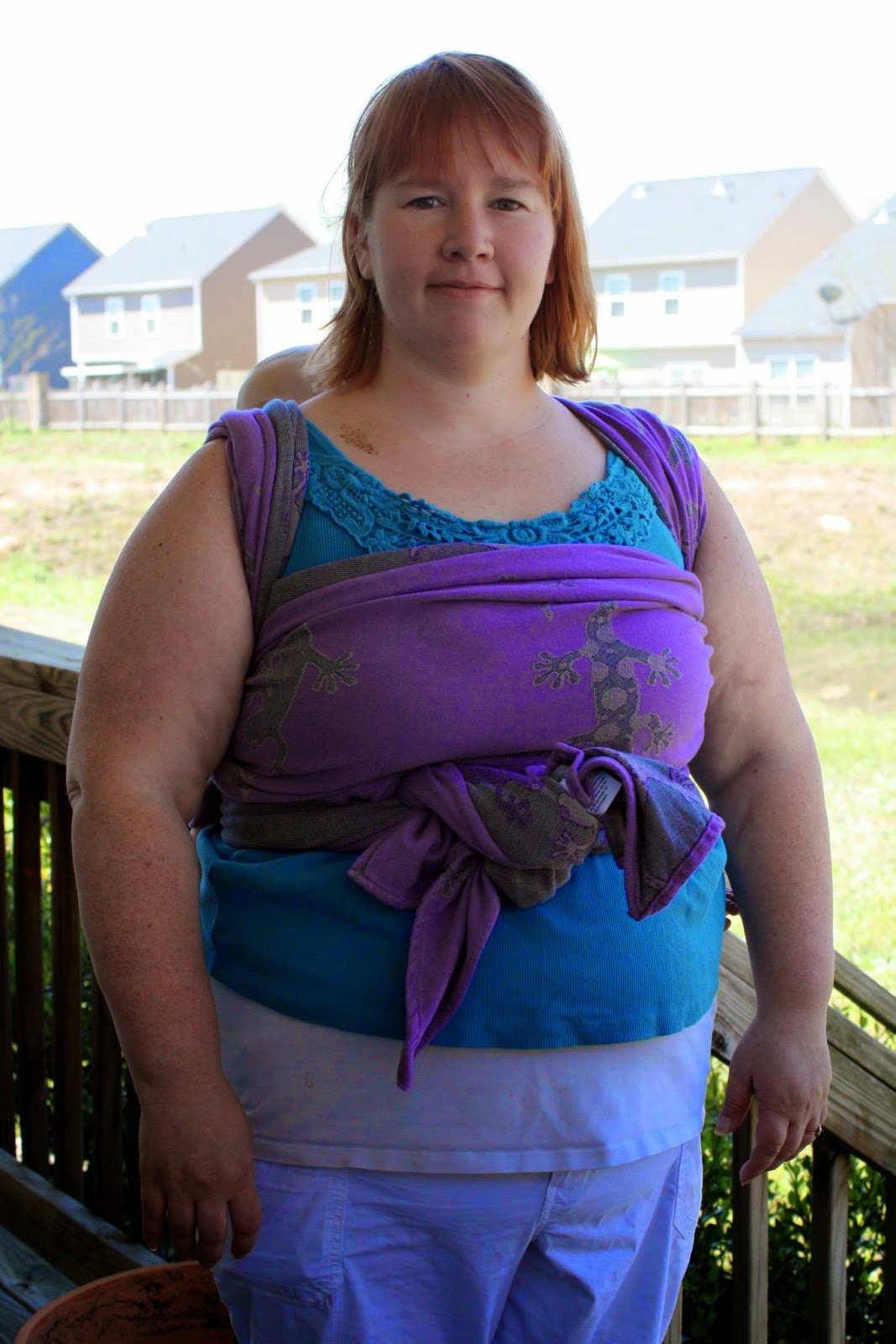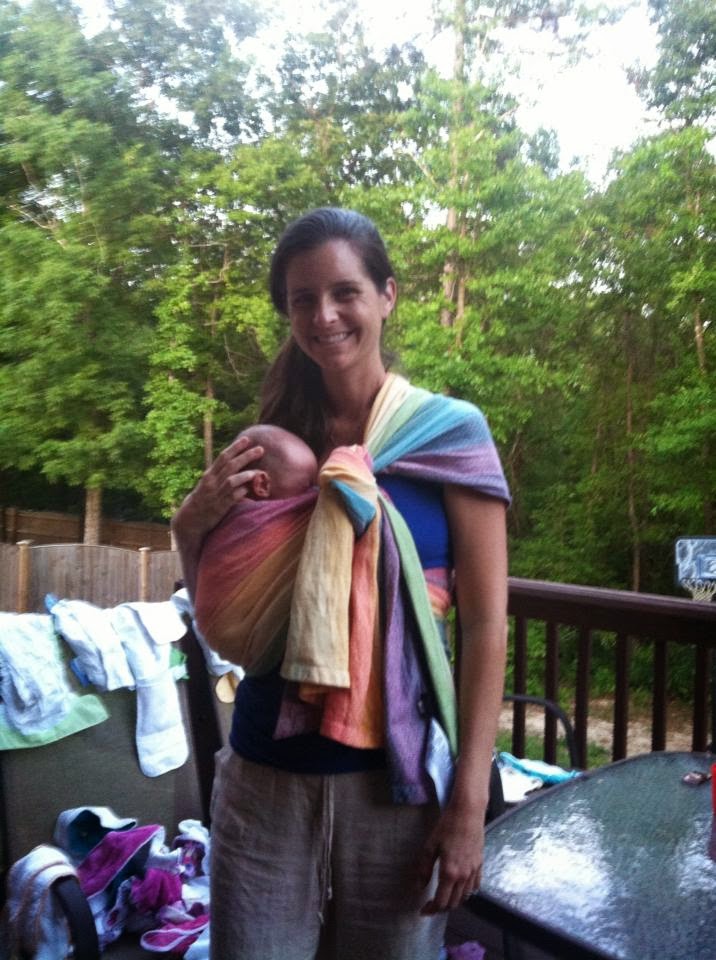Happy Blog Day!
International Babywearing Week is fast approaching - it's October 5th through 11th - and we have so much fun in store for you! You will be hearing a lot about fundraising efforts in the weeks before, and during the week itself. We have T-shirt sales already in progress, a refreshed logo and more t-shirts in the works, and some fantastic prizes that we are working on how to raffle off . . . I mean, really. It's going to be a week-long blitz of babywearing awesomeness.
I know all of you are curious about why we fund raise and where money goes. The majority of all proceeds are used to purchase carriers for the Lending Library. Some funds are used to purchase business cards. Others are used for miscellaneous things that the group needs to get the word out about us, like printing fliers, or other advertising costs (a few publications are free, but many charge a nominal fee to print anything about our events or the group itself). Unlike other groups, we are independent of any larger organization (we are not a Babywearing International Chapter, and International Babywearing Week is not a week sponsored solely by BWI). Since we are independent, we do not charge any membership fees. No portion of the funds we raise is dedicated to a larger body. It all stays local, to benefit existing members and grow our group.
The Lending Library
Shakespeare is often quoted:
Neither a borrower nor a lender be,
For loan oft loses both itself and friend,
And borrowing dulls the edge of husbandry.
Hamlet, Act I scene 3
 |
| Melissa and H borrowed this wrap from Jackie. H loved it so much, Melissa had to get one of her own. |
So what is the Lending Library, exactly?
The Lending Library is a group of carriers "owned" by the group, for the sole purpose of having members try them, borrow them, and return them. Our particular library started mostly from personal donations of the leaders and a few generous members. We've solicited major brands for donations and discounts, and a few have graciously responded. Tula offered us a discount, and thanks to our last fundraiser, we were able to add both a standard and a toddler sized Tula to the Library. Boba generously donated a Boba 4G to our Lending Library just in the last month. We've also won or had donated a few woven wraps. Slowly, our Library is growing.
How does it work?
Can anyone borrow a carrier? Just about. We do require you to attend at least two meetings, or play dates, or a combination of both. Why? We want to get to know you! We also have a responsibility to make sure that you are borrowing a carrier that will work for you (i.e. not borrowing the Toddler Tula when you have a 4 month old), and that you know how to use it before you take it home. We certainly don't expect you to be an expert in its use prior to borrowing it, but we do need to know that you can use it safely, and we expect you to get better as you practice.
How much does it cost? Your first rental is FREE. Subsequent rentals cost $5.00. Whether it's your first or fourteenth rental, you do need to leave a deposit for the replacement value of the carrier. This can be in the form of a check (which is not cashed) or other means (we've done debit card numbers, for example). The check (or other form of deposit) is returned to you intact, when we receive the carrier back.
How long can a carrier be loaned? Right now, the loan term is one month. 30 days to play with, explore, familiarize yourself with a carrier. To figure out if you want to buy one of your own. To determine what does, and does not, work for you. For example, maybe you borrowed the Tula, but after a couple weeks, you realize you don't really like how the shoulder straps fit. Or maybe you took the Kinderpack home and discovered that no matter how hard you try, you just can't get it comfortable. In other words, enough time to really know the carrier and make some solid decisions.
Why do people do more than one loan? Well, for some, because the first thing they tried didn't work for them. Others are just curious. Some parents borrow our carriers as they work to save up for one of their own. Yes, you can buy some carriers more cheaply (like any one of the Infantino line), but often times, after trying on something different, a parent may realize that it really is worth the extra money to get a more expensive carrier.
What's available in the Lending Library?
 |
| A view of our lending library (plus a few additions from our leaders) |
The list below is the full list of what is in our Lending Library.
Woven and Stretchy Wraps:
 |
| from top left: Hybrid stretch, NB Feathers, Didymos Jonas NB Snowflakes, Little Frog woolie (not LL), NB Raspberry (not LL), dark purple wrap, and Didymos Geckos |
- Moby-(Chocolate)
- Sleepy Wrap-(Off White)
Wrapsody Hybrid Stretch- (Brigid/green)
The Wrapsody Hybrid Stretch is one of my favorite options for those on a budget. These are soft, moldable, with just enough stretch, in the right direction, to make for a comfortably supportive carry, yet not so much stretch that they get saggy at a certain weight point. Also, unlike the Moby or Sleepy Wrap, the Hybrid Stretch is thin and breathable, making it much more comfortable to wear in our South Carolina heat. This is the only wrap with stretch that is safe to use in a back carry.
 |
| Brady using the Breeze |
- Wrapsody Breeze- (Kimber)
Ellevil Jade long 4 -
Ellevill Jade is a 100% cotton wrap, so it is easy to care for, on the thinner side, and is well broken in (read: soft). Ellevill wraps are known for having long tapers (tapers are the ends of a wrap, often cut at an angle. When laid out, most wraps are shaped like a parallelogram). The longer tapers make for smaller knots when you are tying, which some people do prefer.
 |
| Emily in Feathers |
What you can probably do with a size 4 wrap. Note that the mama in the link is a tiny 114 lb person. I'm size 16 and I can actually do most of what's on her list with a size 4, too, albeit with shorter tails.
 |
| Hoppediz Acapulco |
Natibaby Winter 6
 |
| Chris, in Winter |
Natibaby Winter is a wool blend wrap. Don't let the wool scare you away! Wool isn't just for winter;
this is not a super thick wrap, and the inherent properties of wool make it a great choice for all seasons, since it wicks away moisture and breathes well. Wool is also notoriously smooshy and comfortable on the shoulders. It does require special care and handling while washing, so please, please, do NOT wash this wrap.
What you can do with a size 6 wrap - for the average parent, this is the base size; in other words, what you can do beginner multi layer carries like Front Wrap Cross Carry and Double Hammock in.
 |
| Katrina, in Geckos |
What you can do with a size 7 wrap.
Ring Slings:
 |
| Emily in the SBP linen |
- Sakura Bloom Double silk (orange and Brown) -
Sleeping Baby is the gold standard in compliant WAHM businesses. This sling has her standard pleated shoulder and is made of oatmeal colored linen, which is a great choice for it's breathability and light weight.
 |
| Katrina in Ellaroo MT |
- Kozy mei tai- (echino owl/tiger)
- Baby Hawk mei tai (star trek)
- Ellaroo- (blue and tan striped)
- Infantino Sash-
Pouches:
- Hotslings pouch- (Brown with white polka dots, size 4)
- Peanut Shell pouch - size small aqua with brown dots
Soft-Structured Carriers:
 |
| All of the SSC available in our Lending Library |
- Ergo (tan with bugs and butterflies, matching infant insert and belt extender)
- Ergo Sport (Black)-
AngelPack is a smaller SSC, some would call it more of a buckle-tai in that the shape of the body is
not as structured as most SSCs, it is more flat and rectangular like a standard mei tai.
- Standard Tula (Spotted Love)-
- Toddler Tula (Prepster) -

- Boba 4G
it - it had a higher back than my previous Ergo making it a good fit for my toddler. I also liked that the waist and shoulder straps were longer, making it a more comfortable fit for my plus size self and extra-tall husband.
Things we are looking to add to the Lending Library:
A Kinderpack - many of you have them, have seen or heard of them, and want to try out their awesomeness. Unfortunately the company itself no longer does Lending Library discounts, so we are on the look out for one at a killer price. If you know of one, please message one of the leaders on Facebook. We did have one in our Library, but it is an older version that has seen a lot of love and is no longer available for lending. We are trying to keep the Library as current as possible, so when you try something and love it, you know what you are buying is very similar to what you already know and love. Ideally, we would love to have both a standard and a toddler sized Kinderpack in our Library.
Woven Wraps: Right now we are on the look out for good shorty wraps. So far our requirements seem to include: different colored rails for ease of use and be made of a sturdy cotton, hemp, or linen blend.
Ring Slings: Ring Slings are also very popular. Any carrier we include in our Library must be made by CPCIA compliant company, so we can not offer any DIY ring slings for loan.
If you have other suggestions of things you'd like to see added to the library, let us know!
























